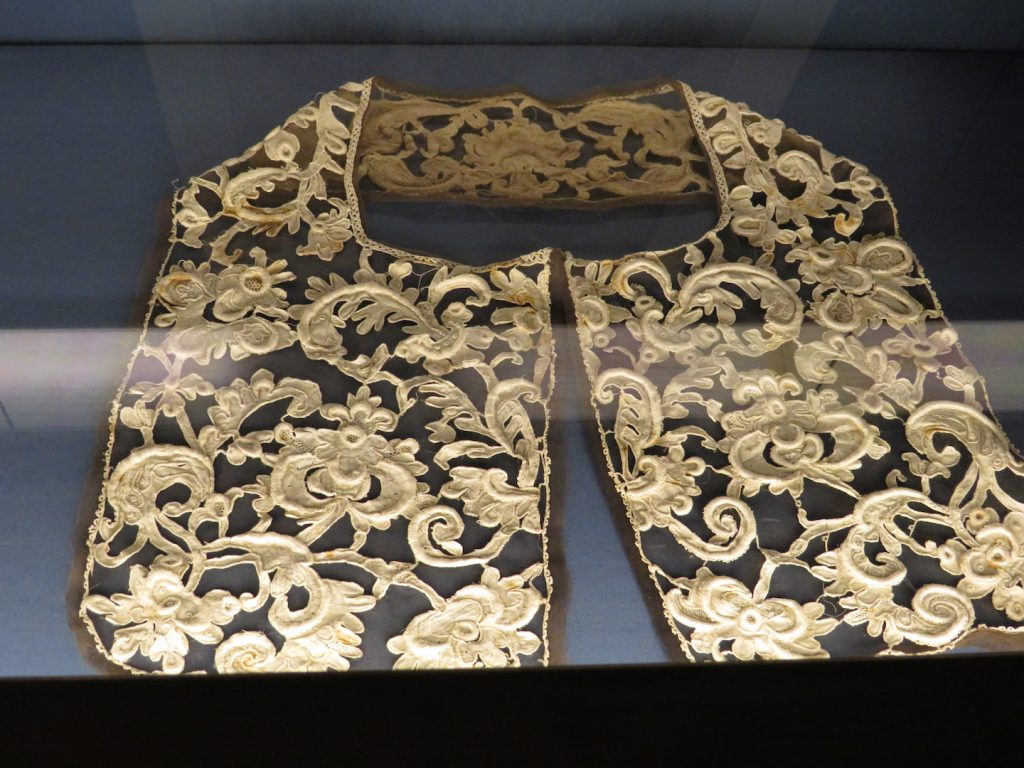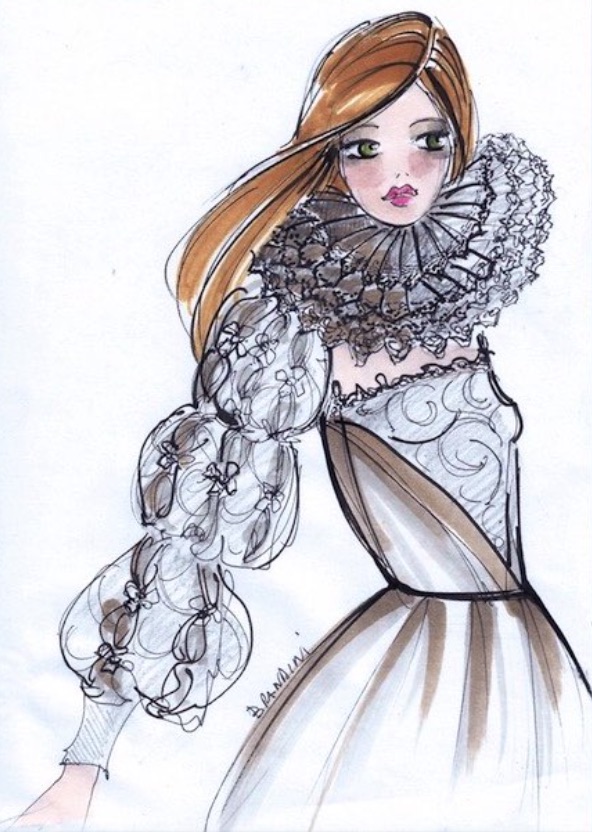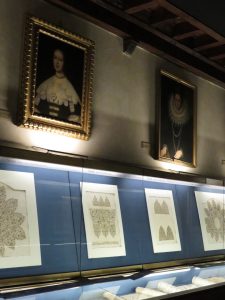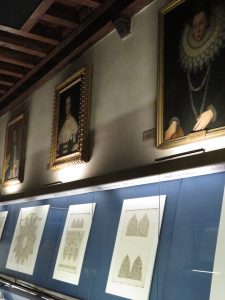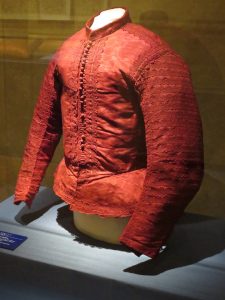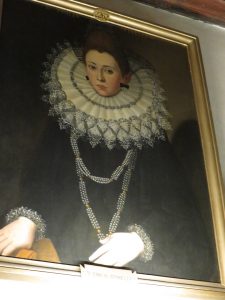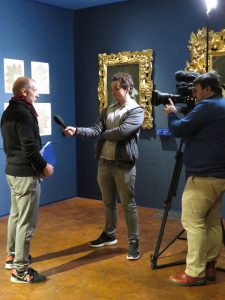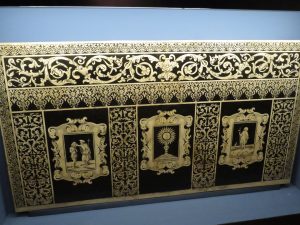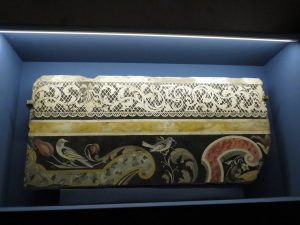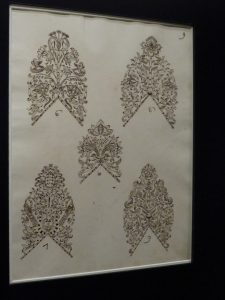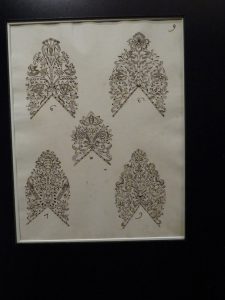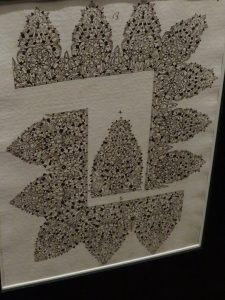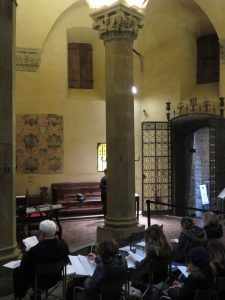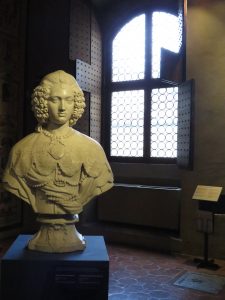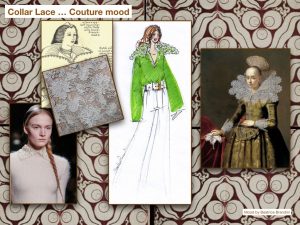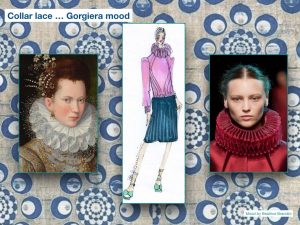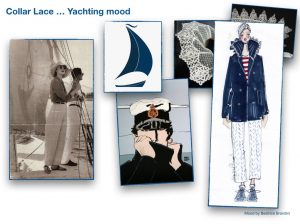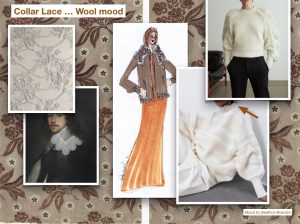Collar at Palazzo Davanzati in the exhibition “Beauty and noble ornaments in the fashion and furnishing of the seventeenth century”.
“Dama” by Beatrice Brandini
At the Palazzo Davanzati Museum in Florence, the exhibition “Beauty and noble ornaments in the fashion and furnishings of the seventeenth century” was presented to the press yesterday, which will open to the public on Sunday 8 December and will remain open until 13 April 2020.
Views of Palazzo Davanzati
The idea of the exhibition was born from the acquisition promoted by the Bargello Museums for Palazzo Davanzati, of a very rare and unpublished corpus of designs for embroidery and lace dating from the first half of the seventeenth century and appeared on the antique market in 2018. It is a of the most extensive and important collections of lace and embroidery designs, in all 105 sheets, arrived to us in an excellent state of preservation and attributable for the most part to the signature of the same author, Giovanni Alfonso Samarco da Bari, an extraordinary draftsman from the undoubtedly graphic talent whose identity is however still little known.
Glimpses of the exhibition at Palazzo Davanzati
In the exhibition we can admire large collars, borders and embroidered friezes, displayed in an interesting path that extends from the entrance floor to the first floor of Palazzo Davanzati.
Glimpses of the exhibition at Palazzo Davanzati
Glimpses of the exhibition at Palazzo Davanzati
Already the dwelling is worth the entrance and ticket of the exhibition, a building, the Davanzati one, wonderful, also known as the Museum of the Ancient Florentine House, a historic fourteenth-century residence of the Davizzi family, merchants and bankers. However it was another family that gave it the name, that of the Davanzati, who bought it in 1578 and enriched the facade with a large coat of arms representing the arms of the family. After many hardships, dating back mainly to the last century, in 1956 it was bought by the State that turned it into a state museum.
Glimpses of the exhibition at Palazzo Davanzati
Glimpses of the exhibition at Palazzo Davanzati
As often happens in Florence, but we could extend this comment to the beautiful Italy and its immense artistic heritage, the locations of the exhibitions are an extraordinary way of enhancing the hosted subject. In fact, here at Palazzo Davanzati, the wide entrance loggia, the suggestive courtyard that allows access to the upper floors, are the perfect setting for these wonderful artifacts that seem to come alive and become works of art.
Glimpses of the exhibition at Palazzo Davanzati
Interview with Benedetta Matucci, curator of the exhibition
Interview with Daniele Rapino, curator of the exhibition
Press conference with the director of the Musei del Bargello, Paola D’Agostino, Daniele Rapino and Benedetta Matucci
The exhibition aims to document the precious style of seventeenth-century fashion, through a comparison between works of art, clothes, accessories, books, medals, lace and embroidery. Like the rare men’s jacket from the late sixteenth century, with bobbin lace inserts, or some paintings depicting sumptuous lace collars worn by Valdemarco of Denmark and Vittoria Bulgarini, portrayed by Justus Suttermans and Nicolas Régnier respectively.
Glimpses of the exhibition at Palazzo Davanzati, paliotto private collection Bianco Bianchi, Firenze
“For the duration of the exhibition, the Davanzati, known to most as an ancient Florentine home, will dress in refined baroque forms, with “rooms of wonders” that will reveal, through a fascinating exhibition, the unique role that lace had in social history and economic in Europe, besides in the history of art, design and fashion “(Paola D’Agostino, Director of the Musei del Bargello).
Preparatory designs of lace by Giovanni Alfonso Samarco from Bari
The exhibition also aims to highlight, through a careful selection of lace from the rich collection of the Museum, the comparison between the drawings acquired and the finished article, a sort of creative process, from the drawing to its final realization. Therefore, speaking of seventeenth-century lace and textile artefacts, it is truly a unique occasion that this very interesting exhibition offers us.
Views of Palazzo Davanzati
Infinite ways of interpreting collars today, by Beatrice Brandini
Thanks for this “gift”, and thanks to the craftsmen of Italian craftsmanship (lace and embroidery) that even through the centuries have left us so much wealth, making us understand how the “Made in Italy” was already a reality. Even in the seventeenth century was exported the creativity, good work and the ability to create something unique that in no other place “was worth” the same.
Good life to everyone!
Beatrice


